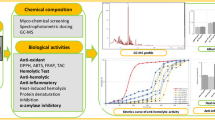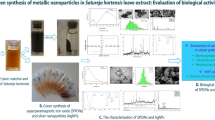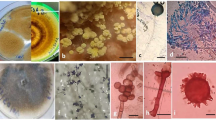Abstract
Cytotoxicity and giant cell formation induced by lemon yellow and orange red synthetic food colorants were evaluated in the present study. The aqueous solutions of both the dye solutions were tested for cytotoxicity using Allium cepa assay. Frequency of giant cells were determined after treating the root tips with different concentrations of both food colorant solutions viz., 0.005, 0.01, 0.05, 0.1 % for varying time durations (1/2, 1, 2, 3 h). These colorants may cause giant cell formation primarily by interfering with the normal course of mitosis. Giant cells showing multiple aberrations viz. bridged and binucleate condition, cellular fragmentation, nuclear lesion, double and multiple nuclear lesions, double nuclear peaks and cellular breakage, elongated nucleus, nuclear budding, hyperchromasia, micronucleus, nuclear erosion, pulverized nucleus etc. were induced in root tips treated with both of the colorants. The synthetic food colorant treated cells showed inhibition of cell division and induction of giant cells. A dose dependant decrease in the mitotic index [88.20 % (c−ve, 3h) to 81.54 % (Lx4, 3h) and 88.20 % (c−ve, 3h) to 73.17 % (Ox4, 3h)] was observed. All mitotic phases show significant induction of giant cells when treated with both food colorants. Interphase stage shows higher percentage of giant cells, whereas in cytokinesis it was negligible. The orange red food colorant is observed to be more toxic because it recorded higher percentage of giant cell induction when compared with lemon yellow [27.93 % (Lx4, 3h) and 28.07 % (Ox4, 3h)].



Similar content being viewed by others
References
Akaneme FI, Iyioke IV (2008) Mutagenic potentials of the sterilizing fluid-purital on root tip mitosis of Allium cepa. Bio-Research 6:293–297
Amin KA, Hameid HA, Elsttar AHA (2010) Effect of food azo dyes tartrazine and carmoisine on biochemical parameters related to renal, hepatic function and oxidative stress biomarkers in young male rats. J Food Chem Toxicol 48:2994–2999
Atri R, Singh A, Mathur N, Verma A (2014) Utilization of microbial bioassays for screening the possible toxicity in regularly used food dyes. J Chem Bio Phy Sci Sec B 4:1248–1257
Badr A, Ibrahim AG (1987) Effect of herbicide ‘Glean’ on mitosis, chromosomes and nucleic acids in Allium cepa and Vicia faba root tip meristems. Cytologia 52:293–302
Bakkali F, Averbeck S, Averbeck D, Idaomar M (2008) Biological effects of essential oil—a review. J Food Chem Toxicol 46:446–475
Bansal AK (2005) Modulation of N-nitrosodiethylamine induced oxidative stress by vitamin E in rat erythrocytes. Human Exp Toxicol 24:297–302
Baumstark-Khan C, Rink H, Zimmermann HP (1986) Radiation induced formation of giant cells in Saccharomyces uvarum III. Effect of X-rays on nuclear division. Radiat Environ Biophys 25:23–30
Chinoy NJ, Sorathia HP, Jhala DD (2005) Fluoride + aluminium induced toxicity in mice testis with giant cells and its reversal by vitamin C. Fluoride 38:109–114
Chung KT, Fulk GE, Egan M (1978) Reduction of azo dyes by intestinal anaerobes. Appl Environ Microbiol 35:558–562
Combes RD, Haveland-Smith RB (1982) A review of the genotoxicity of food, drug and cosmetic colors and other azo, triphenylmethane and xanthene dyes. Mutat Res 98:101–248
Cross SM, Sanchez CA, Morgan CA, Schimke S, Ramel RL, Idzerda WH, Raskind WH, Reid BJ (1995) A p53-dependent mouse spindle checkpoint. Science 267:1353–1356
D’Souza UJA (2003) Tamoxifen induced multinucleated cells (symplasts) and distortion of seminiferous tubules in rat testis. Asian J Androl 5:217–220
Fukasawa K, Choi T, Kuriyama R, Rulong S, Woude GFV (1996) Abnormal centrosome amplification in the absence of p53. Science 271:1744–1747
Gao Y, Li C, Shen J, Yin H, An X, Jin H (2011) Effect of food azo dye tartrazine on learning and memory functions in mice and rats, and the possible mechanisms involved. J Food Sci 76:125–129
Gernand D, Rutten T, Varshney A, Rubtsova M, Prodanovic S, Bruss C, Kumlehn J, Matzk F, Houben A (2005) Uniparental chromosome elimination at mitosis and interphase in wheat and pearl millet crosses involves micronucleus formation, progressive heterochromatinization and DNA fragmentation. Plant Cell 17:2431–2438
Hellgren L, Morre DJ (1992) ATP induced budding of nuclear envelope in vitro. Protoplasma 167:238–242
Hong YC, Choi SS (1997) Cytotoxicity and multinucleate giant cell formation in Chinese hamster lung fibroblast caused by crocidolite and chrysotile. J Korean Med Sci 12:99–104
Hossain Z, Shukla R, Mandal AKA, Datta SK (2002) Allium test for assessing chromotoxic effects of artificial yellow dye. Cytologia 67:411–415
Ianzini F, Mackey MA (1997) Spontaneous premature chromosome condensation and mitotic catastrophe following irradiation of HeLa S3 cells. Int J Radiat Biol 72:409–421
Joint Expert Committee on Food Additives (JECFA). (1995) Summary of evaluations performed by the Joint FAO/WHO Expert Committee on Food Additives. 44th meeting, 14–23 February 1995. Geneva (Switzerland): FAO/IPCS/WHO, Geneva, pp 1956–1996
Joseph N, Siril EA (2010) Cytotoxic evaluation of Annatto (Bixa orellana L.) dye compared with orange red. Cytologia 75:163–167
Karen L, Mclean WG, Williams DP, Howard CV (2006) Synergistic interactions between commonly used food additives in a developmental neurotoxicity test. Toxicol Sci 46:177–184
Kaur A, Singh R, Grover IS (1993) Mutagenicity testing of textile dyes with Salmonella microsome assay. J Environ Biol 14:327–333
Kenne K, Ljungquist S, Ringertz NR (1986) Effects of asbestos fibers on cell division, cell survival and formation of thioguanine resistant mutants in Chinese hamster ovary cells. Environ Res 39:448–464
Khanna SK, Mukul D (1991) Toxicity, carcinogenic potential and clinicoepidemiological studies on dyes and dye intermediates. J Sci Ind Res 50:965–974
Koutsogeorgopoulou L, Maravelias C, Methenitou G, Koutselinis A (1998) Immunological aspects of the common food colorants, amaranth and Tartrazine. Vet Hum Toxicol 40:1–4
Majewska AE, Wolska E, Sliwinska M, Furmanowa N, Urbanska A, Pietrosiuk A, Zobel A, Kuras M (2003) Antimitotic effect, G2/M accumulation, chromosomal and ultrastructure changes in meristematic cells of Allium cepa L. root tips treated with the extract from Rhodiola rosea roots. Caryologia 56:337–351
Martin H (2007) Soft drinks cause degenerative DNA diseases. http://news.indep endent.Co.uk/healtharticle
Menzel D (1988) How do giant plant cells cope with injury? The wound response in siphonous green algae. Protoplasma 144:79–91
Mercykutty VC, Stephen J (1980) Adriamycin induced genetic toxicity as demonstrated by the Allium test. Cytologia 45:769–777
Miller ME, Lummus ZL, Bernstei DI (1996) Occupational asthma caused FD8 and C blue dye No. 2. Allergy Asthma Proc 17:31–34
Morgan WF, Day JP, Kaplan MI, Mc Ghee EM, Limoli CL (1996) Genomic instability induced by ionizing radiation. Radiat Res 146:247–258
Mpountoukas P, Pantazaki A, Kostareli E, Christodoulou P, Kareli D, Poliliou S, Mourelatos C, Lambropoulou V, Lialiaris T (2010) Cytogenetic evaluation and DNA interaction studies of the food colorants amaranth, erythrosine and tartrazine. J Food Chem Toxicol 48:2934–2944
Roy K, Kodama S, Suzuki K, Watanabe M (1999) Delayed cell death, giant cell formation and chromosome instability induced by X-irradiation in human embryo cells. J Radiat Res 40:311–322
Sakari K, Martti S, Pekka V (1981) Chromosome pulverization in blood diseases. Hereditas 95:15–24
Saleem N, Umar ZN, Khan SI (2013) Survey on the use of synthetic food colors in food samples procured from different educational institutes of Karachi city. J Trop Life Sci 3:1–7
Sharma AK, Sharma A (1990) Chromosome techniques-theory and practice, 3rd edn. Butterworths, London
Shukla R, Datta SK (1999) Cytotoxic effects of artificial blue dye. J Cytol Genet 34:95–97
Somesh Y, Meenu S, Kumar SH (2005) Evaluation of cytotoxicity of some synthetic food colours. Int J Plant Res 18:55–65
Sorouraddin MH, Saadati M (2010) A simple fabrication of portable diffuse reflectometer for simultaneous analysis of common food dyes. Sensor Actuat B-Chem 145:367–372
Sudhakar R, Gowda KNN, Venu G (2001) Mitotic abnormalities induced by silk dyeing industry effluents in the cells of Allium cepa. Cytologia 66:235–239
Verma DPS, van Huyste RB (1971) Induction of giant cells in suspension cultures of Arachis hypogea L. by massive irradiation. Radiat Res 48:518–530
Acknowledgments
P. V. kindly acknowledges Kerala State Council for Science, Technology and Environment for providing financial assistance through KSCSTE fellowship.
Author information
Authors and Affiliations
Corresponding author
Rights and permissions
About this article
Cite this article
Prajitha, V., Thoppil, J.E. Induction of giant cells by the synthetic food colorants viz. lemon yellow and orange red. Cytotechnology 68, 443–450 (2016). https://doi.org/10.1007/s10616-014-9797-x
Received:
Accepted:
Published:
Issue Date:
DOI: https://doi.org/10.1007/s10616-014-9797-x




